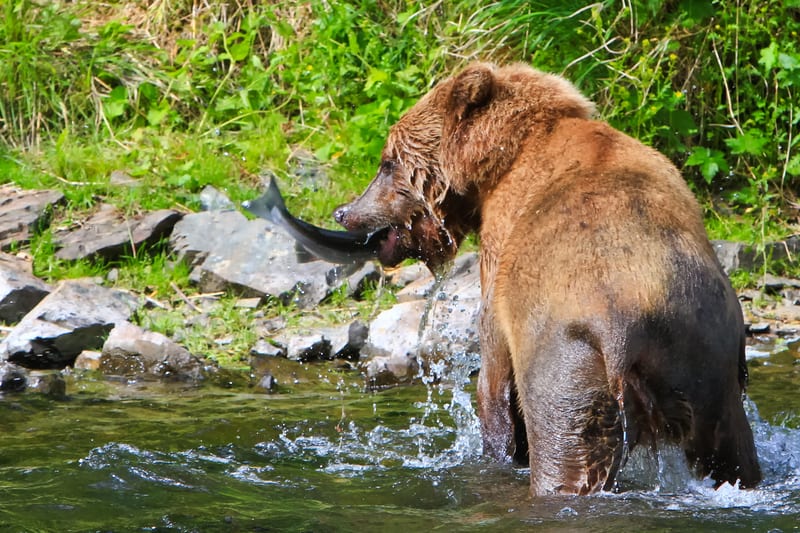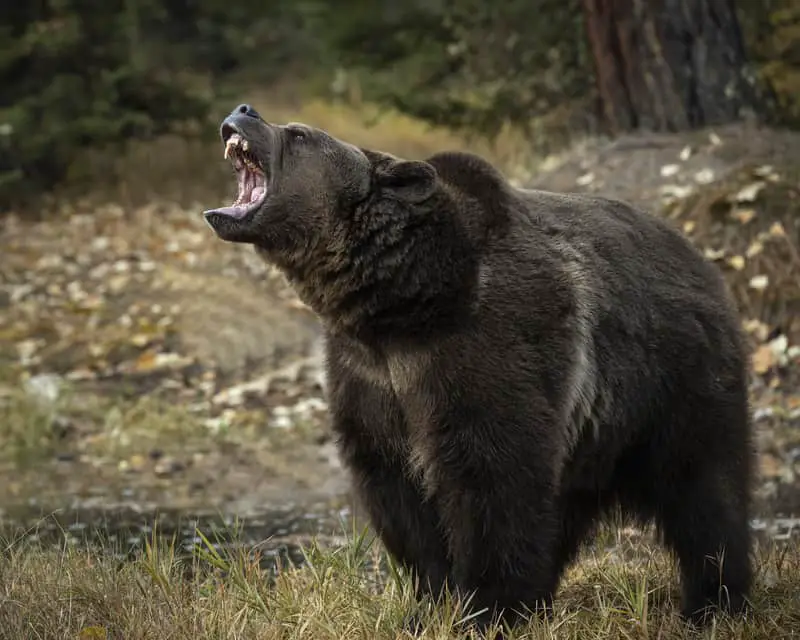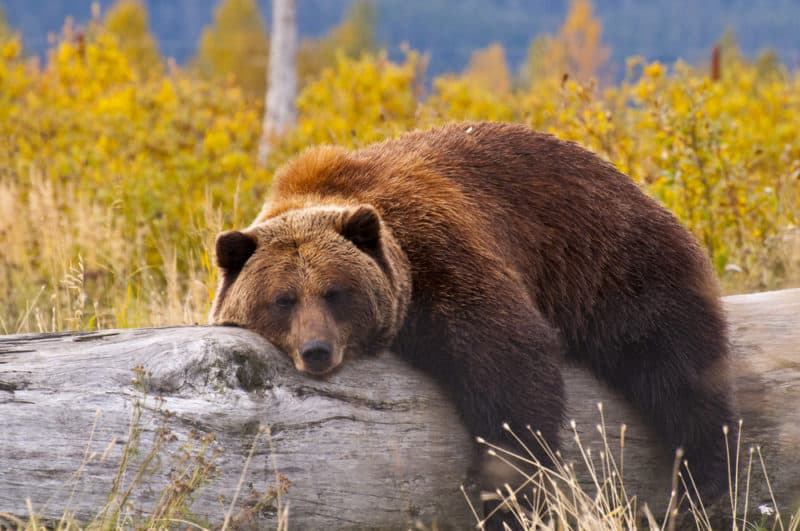Grizzlies live in the wilderness of the western United States and Canada. If you’re an enthusiast of the outdoor Rocky Mountain West, you’ll likely spend some time in Grizzly Bear country occasionally. This article is on how to live in Grizzly Bear Country.
The grizzly bear was given the Latin name (Ursus arctos horribilis) by the zoologist George Ord. Ord was reasonable for classifying specimens brought back from the American interior by the Lewis and Clark expedition. The Lewis and Clark journals are replete with scrapes and close calls with these fierce predators, thus inspiring Ord’s scientific classification.
The North American grizzly bear is typically brown, with white-tipped or grizzled fur, and this is where their name originates from. Grizzlies are large, and their color ranges from light tan to dark brown.
Alaskan Brown Bears are Grizzly Bears. When we talk about Brown Bears, we’re talking about those animals that live along coastal regions and have access to a more abundant food supply. Brown Bears are larger than inland Grizzlies.
- The Difference Between Grizzlies And Black Bears
- Where Are Grizzly Bears in the United States?
- Where Are Grizzly Bears Found In Canada?
- How Do Grizzly Bears Get Their Food?
- Do Grizzly Bears Hibernate?
- Can a Bear Smell Food in a Car?
- How Often Do Grizzly Bears Attack Humans?
- How Do You Camp in Bear Country?
- How to Avoid Bears While Your Hiking
- If You Should Run Into a Bear on the Trail
- Should You Play Dead With a Bear?
- What If Its a Predatory Attack?
- Enjoy Your Time In the Great Outdoors

The Difference Between Grizzlies And Black Bears
Clearly, identifying the difference between a grizzly bear and a black bear can sometimes be tricky. However, grizzlies are generally larger, but a younger grizzly is no larger than a Black Bear. You can distinguish them from black bears by their long-curved claws, short, rounded ears, short non-existent tail, the hump of muscle between their shoulders, and their concave-like face. The hump gives the bears extra strength in their front end, whereas the long claws on their front feet provide them with the ability to dig for food and create dens.
Large adult Grizzlies measure about 2.5 meters (8 feet) in length and weigh 410 kg (900 pounds) on average. The males are usually heavier than the females. A large male can weigh up to 1,700 pounds (770 kilograms). Grizzlies’ adult claws measure about 4 inches long and tend to be slightly curved.
Grizzlies require a lot of territory. The average size of a female bear’s home range is 70 square miles. The size of an adult male’s home range is 300 to 500 square miles.
Where Are Grizzly Bears in the United States?
- There are around 30,000 Grizzly Bears in the state of Alaska.
- Montana has around 800 Grizzly Bears.
- Wyoming has around 600 Grizzly Bears.
- Idaho has around 100 Grizzly Bears.
- Washington State has an indeterminant number of Grizzly Bears. They live in the Selkirk and Cascade Mountains Source
Where Are Grizzly Bears Found In Canada?
- Around 14,000 Grizzly Bears live in British Columbia.
- Around 700 Grizzly Bears live in Alberta. Source
- There are 4 to 5,000 Grizzly Bears in the Northwest Territories. Source
- Nunavut has 2,000 Grizzly Bears.
- There is an indeterminant number of Grizzly Bears in Northern Manitoba.
How Do Grizzly Bears Get Their Food?
Grizzlies spend most of their time looking for food. Plants contribute to 90 percent of their diet on most days. They are, however, omnivorous. Their diet consists of berries, seeds, rodents, fish, birds, insects, and small mammals.
Grizzly bears that live near salmon rivers are very good at fishing. They deploy various fishing methods. At times the bear stands near the water bank, flips the salmon out with its paw, or sits silently on a rock by the deep waters, eagerly waiting for a salmon to swim by. Once it spots a fish, it quickly dives in and captures the unsuspecting fish.
These bears will also hunt larger prey. They are even capable of killing an adult moose. They kill by latching onto the neck above the shoulders and wringing the neck of their prey. Thereafter, the bear covers its kill carefully and keeps a close eye on the carcass.
Due to the frequent change in food sources that occur as the seasons change, grizzlies move around to keep feeding options open. They normally migrate to feed themselves based on their experience and hunting knowledge. Grizzly bears live in forests, woodlands, alpine meadows, and prairies. Most of them prefer to live in riparian areas along rivers and streams.
Do Grizzly Bears Hibernate?
Grizzlies are well known for feeding through winter and only revert to hibernation once food becomes scarce. In this case, these bears can hibernate for up to eight months. Their hibernation period depends on the duration of time that cold weather persists.
Can a Bear Smell Food in a Car?
Yes, a bear can smell food in your car. This is because bears have a great sense of smell. A bear’s sense of smell is approximately 2,100 times better than ours. Bears often vandalize cars because they’re trying to get at the food they smell. It’s best to find a different food storage solution like bear bags or a food vault.

How Often Do Grizzly Bears Attack Humans?
Grizzlies rarely attack human beings. However, they are unpredictable and mighty destructive forces when they decide to be.
For perspective, there is, on average, one Grizzly Bear caused injury in the backcountry of Yellowstone National Park each year. Most bear attacks take place when the human invades the bear’s space. The bear becomes agitated: hikers, hunters, fishers, and people who camp are the most at risk.
How Do You Camp in Bear Country?
- It’s a no-brainer but avoid setting up your campsite on trails or in areas with an abundant bear sign.
- When your camping in Grizzly or Black Bear country, for that matter, the place you sleep should be a good distance from where you cook and store your food.
- Avoid strong-smelling foods such as bacon.
- Keep pets on a leash.
- Store your food, garbage, and any other aromatic items such as toothpaste and cosmetics at least ten feet off the ground in a bear bag.
- Never bring food to your sleeping area.
- Do not sleep in the clothes that you prepared food in
- Sleep in a tent. A tent will give you a little more time to get your wits about you if a bear should visit you in the night.
- Keep a flashlight and a canister of bear spray in your tent at night. In Alaska between 1985 and 2006, 98 percent of people carrying bear spray who got into close encounters with bears were uninjured. Source
- If a bear enters your camp and ignores your efforts to send him on his way, it’s time to back out of there. There are no material possessions in your camp worth risking bodily harm or death to protect.
- From Shocking Bears Electric Fences for backcountry campers. “Today, electric fences are surprisingly lightweight and portable, and units powered by two D-cell batteries are available for backpackers. Models weighing less than four pounds, running about $300, will enclose a 30 ft. x 30 ft. area and deliver a charge of about 6,000 volts.” Source Electric bear fence is now commercially available, and some people use them around their sleeping areas in the backcountry. They shouldn’t be construed as a substitute for a clean camp, but using one could shift the odds a little more in your favor to stay safe.
- Also, see Camping in Bear Country

How to Avoid Bears While Your Hiking
- Bears are most active in the early morning hours and at dusk. Avoid hiking at these times.
- Hike in a group. You’ll be much safer than you would be hiking alone.
- Make noise. If you let them know your coming, you give them a chance to avoid you. Some people wear a bell when hiking.
- Carry bear Spray Source
If You Should Run Into a Bear on the Trail
- Avoid the urge to run away. If it so chooses, the bear has the ability to run you down with little effort on its part. Running will probably invite him to chase you. Bear in mind; grizzlies can do 35 miles an hour.
- If the bear hasn’t noticed, you quietly leave the area while doing your best not to be noticed.
- If the bear has noticed you, remain as calm as possible talk quietly to the bear. Move your arms out to your sides. You want the bear to realize as quickly as possible that you’re a human.
- While avoiding direct eye contact, you need to watch to see what the bear will do next.
- The best outcome is if he runs away. If this happens, leave the area in a different direction than the bear.
- The bear may seem to ignore you or continue to look at you without approaching you. If this happens, continue to talk to the bear while backing away. Don’t turn your back or take your eyes off the bear until you can no longer see each other.
- The bear could approach you. At this point, it’s a lot to ask, but you need to remain as calm as possible. Do not run. Stand your ground. Observe the bear for clues to its mood or intentions.
- A bear that woofs, chomps its teeth, growls, or slaps the ground with its front paws, is stressed by your presence. As hard as this sounds, it would be best if you continued to talk to the bear and act in a non-threatening manner. If the bear charges, you need to stand your ground. When the bear stops, its charge, or backs away, you need to resume slowly backing up.
Should You Play Dead With a Bear?
- If this type of bear completes its charge and begins to attack you, play dead. Accept the fact that you’re probably going to take on some bodily damage, but you’re going to survive by doing the right thing in playing dead.
- Lay face down on the ground with your hands and arms protecting the back of your head and neck. If the bear rolls you over, continue to roll until you are on your stomach again.
- Don’t move and don’t make any noise until your sure the bear has left the area. If you move too soon, the bear might resume its attack. Source
- The previous instructions are given with the assumption that you don’t have bear spray. If I were hiking in Grizzly country, I’d be carrying bear spray, and I would be familiar with how to use it.
What If Its a Predatory Attack?
The previous section ends with instructions on swinging the odds in your favor when the bear’s motivation for the attack is defensive. Most Grizzly attacks are defensive in nature.
- On rarer occasions, a bear will approach you because it’s interested in making a meal out of you.
- This type of bear doesn’t make any noise. It comes at you with its ears pointed forward, and it’s concentration focused on you. If you try to back up, the bear will follow you in a slow, deliberate manner.
- If you find yourself in this situation, it’s time to act aggressively towards the bear. Make yourself look as tall as possible and send the message to the bear that you won’t be an easy meal. If there’s a big stick close by, pick it up and prepare to defend yourself.
- With this kind of bear, situation make direct eye contact and make it plain that you’re prepared to fight. Mentally prepare yourself to fight for your life if necessary. It won’t do any good to play dead if the beast intends to eat you.
- Although they’re scarce in regards to Black Bears, most Black Bear attacks are predatory in nature. It’s not recommended that you play dead in a Black Bear attack.
- Act aggressively towards a Black Bear and let in know you won’t be an easy meal. Source
- Did I mention carry bear spray? I think I have, but I’ll mention it again. Cary a canister of bear spray on your person at all times and be well versed on when and how to use it.
- Carrying a pistol for backup to your canister of bear spray isn’t a bad idea, but the bear spray should be your first line of defense. You’d need to be a crack shot and an awfully cool customer to stop a charging grizzly with a pistol before it reaches you.
Enjoy Your Time In the Great Outdoors
If you are in Grizzly country, you are not in an ugly place. The chances of an incident with a bear are extremely slim. If you go into Grizzly country, go prepared, though. You’ll enjoy your time that much more, and you’ll swing the odds in your favor that any encounter with a bear won’t be a tragic one.
Recent Posts
The only venomous snakes in Washington State are Northern Pacific Rattlesnakes. The Northern Pacific Rattlesnake (Crotalus oreganus oreganus) is a sub-species of the Western Rattlesnake. Anyone...
Skunks are not classified as true hibernators. But they go into a state of torpor when the weather gets cold. Skunks are light sleep hibernators, along with opossums, bears, and raccoons. ...

